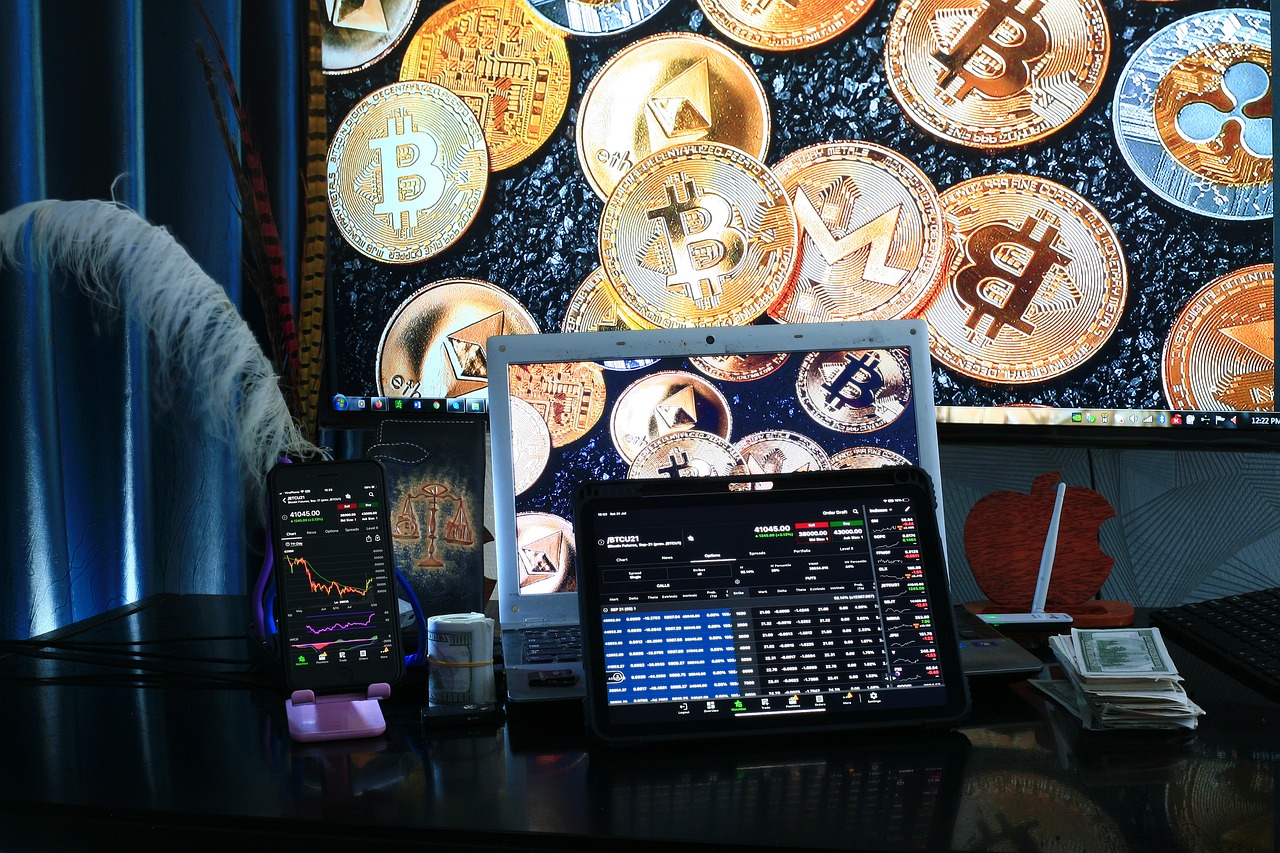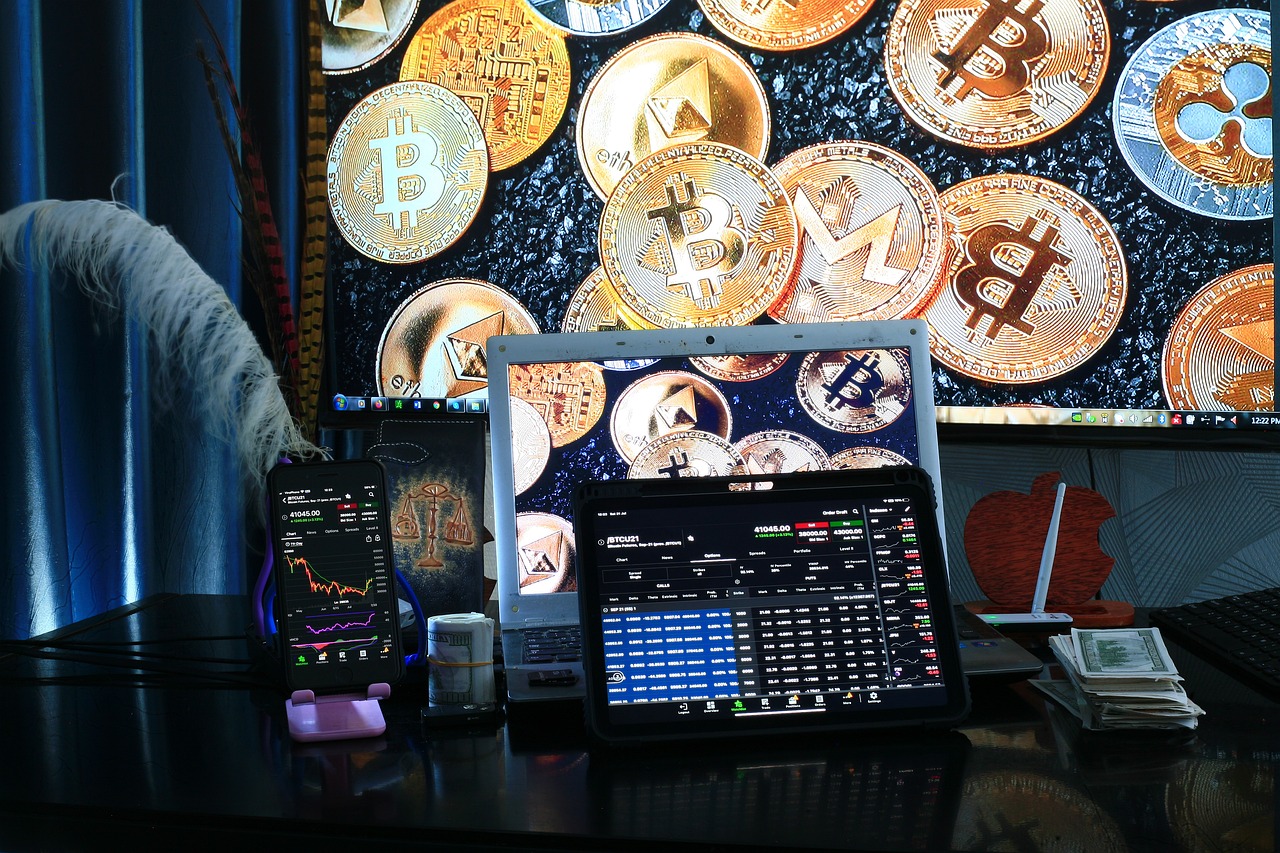How to Analyze Crypto Market Cap Trends
In the ever-evolving world of cryptocurrencies, understanding how to analyze market cap trends is essential for making informed investment decisions. Market capitalization, often referred to as market cap, serves as a key indicator of a cryptocurrency's value and its overall standing in the market. By assessing market cap trends, investors can gain insights into potential price movements and the underlying factors driving those changes. This article will guide you through various methods to effectively analyze cryptocurrency market cap trends, helping you navigate this complex landscape with confidence.
Market capitalization is a crucial metric in the crypto world. But what exactly is it? At its core, market cap is calculated by multiplying the current price of a cryptocurrency by the total number of coins in circulation. For instance, if a cryptocurrency is priced at $50 and there are 1 million coins available, the market cap would be $50 million. This figure provides a snapshot of the cryptocurrency's value and can help investors gauge its size relative to others in the market. Understanding market cap is essential because it can influence investment strategies and decisions. A higher market cap often indicates a more stable investment, while lower market caps can signify higher volatility but also greater potential for growth.
Several factors can impact a cryptocurrency's market cap, creating a dynamic interplay that investors must navigate. Key influences include:
- Demand and Supply: The basic economic principle of supply and demand plays a significant role in market cap fluctuations.
- Technological Advancements: Innovations in blockchain technology can enhance a cryptocurrency's utility, attracting more investors.
- Market Sentiment: Public perception and news can sway demand, leading to rapid changes in market cap.
The relationship between supply and demand is fundamental to market cap trends. When demand for a cryptocurrency increases, its price typically rises, leading to a higher market cap. Conversely, if supply outstrips demand, prices can fall, resulting in a decreased market cap. Understanding these dynamics is crucial for investors looking to predict market movements and capitalize on potential opportunities.
Different cryptocurrencies employ various token supply mechanisms, such as inflationary and deflationary models. Inflationary models increase the supply of tokens over time, potentially diluting value. In contrast, deflationary models reduce supply, often increasing demand and value. By understanding these mechanisms, investors can better gauge potential market cap shifts and make more informed decisions.
Market sentiment is another pivotal factor influencing price movements. Positive news, such as successful partnerships or technological breakthroughs, can lead to increased demand and a higher market cap. On the other hand, negative news can trigger panic selling, resulting in significant drops in market cap. Keeping an eye on market sentiment, including social media trends and news articles, can provide valuable insights into potential price changes.
Innovations in blockchain technology can significantly influence market cap. For instance, a cryptocurrency that introduces a new feature or improves its scalability may attract more investment, leading to a surge in market cap. Staying informed about technological developments is vital for investors looking to capitalize on emerging trends in the crypto space.
Utilizing the right tools is essential for effective market cap analysis. Various platforms and resources can aid in tracking market trends, providing investors with the data they need to make informed decisions. Popular crypto analytics platforms offer real-time data on market cap, trading volumes, and price movements, allowing investors to stay ahead of the curve.
Several analytics platforms provide valuable insights into market cap trends. Some of the most reliable tools include:
- CoinMarketCap: A widely-used platform that offers comprehensive data on market cap, trading volume, and historical price trends.
- CoinGecko: This platform provides extensive information about cryptocurrencies, including market cap rankings and community engagement metrics.
- TradingView: A powerful charting tool that allows users to visualize market cap trends and technical indicators.
Effective data visualization can enhance understanding of market cap trends. Utilizing charts and graphs can help investors quickly identify patterns and anomalies in market behavior. Tools like Tableau or even Excel can be invaluable for creating visual representations of market data, making it easier to analyze trends over time.
Interpreting market cap trends requires a keen understanding of market behavior. Investors should look for patterns and correlations between market cap changes and external factors, such as regulatory developments or economic events. By analyzing these trends, investors can make more informed decisions about when to enter or exit the market.
Recognizing the signs of bull and bear markets is crucial for investors. A bull market is characterized by rising prices and increasing market cap, while a bear market features declining prices and shrinking market cap. Key indicators to help identify these market conditions include:
- Price Trends
- Trading Volume
- Market Sentiment
Differentiating between long-term and short-term market cap analysis strategies can significantly impact investment outcomes. Long-term analysis focuses on broader trends and fundamentals, while short-term analysis seeks to capitalize on immediate market movements. Understanding the benefits and drawbacks of both approaches can help investors develop a balanced strategy tailored to their goals.
Investors often encounter pitfalls when analyzing market cap trends. Common mistakes include overreliance on market cap alone and ignoring the broader market context. By being aware of these pitfalls, investors can enhance their analysis and make more accurate assessments.
Relying solely on market cap can lead to misguided investment decisions. While market cap is an important metric, it should be considered alongside other factors, such as project fundamentals and technological advancements. A holistic approach to analysis can provide a more comprehensive view of a cryptocurrency's potential.
Understanding the broader market context is essential for accurate analysis. Factors such as regulatory changes, macroeconomic trends, and technological advancements can all influence market cap data. By considering these external factors, investors can gain a clearer picture of the market landscape and make more informed decisions.
Q: What is market capitalization in cryptocurrency?
A: Market capitalization is the total value of a cryptocurrency, calculated by multiplying its current price by the total number of coins in circulation.
Q: Why is market cap important for investors?
A: Market cap helps investors gauge the size and stability of a cryptocurrency, informing their investment strategies.
Q: How can I analyze market cap trends effectively?
A: Utilize analytics platforms, monitor market sentiment, and consider technological developments to analyze market cap trends effectively.

Understanding Market Capitalization
Market capitalization, often referred to as market cap, is a fundamental metric in the cryptocurrency world. It serves as a barometer for the overall value of a cryptocurrency and plays a crucial role in investment decisions. But what exactly is market cap? Simply put, it is the total market value of a cryptocurrency's circulating supply. The calculation is straightforward: you multiply the current price of the cryptocurrency by the total number of coins in circulation. For instance, if a cryptocurrency is priced at $50 and there are 1 million coins in circulation, the market cap would be $50 million.
Understanding market cap is essential for investors as it provides insight into the relative size and stability of a cryptocurrency. A higher market cap usually indicates a more established and stable asset, while lower market caps can suggest higher volatility and risk. However, it’s important to note that market cap alone does not determine a cryptocurrency's potential for growth or its long-term viability. Investors should consider other factors, such as technology, use cases, and market sentiment, when evaluating a cryptocurrency.
To further illustrate the significance of market cap, let’s look at the different categories of cryptocurrencies based on their market capitalization:
| Market Cap Category | Market Cap Range | Characteristics |
|---|---|---|
| Large-Cap | Over $10 billion | Generally more stable, less volatile, and widely adopted. |
| Mid-Cap | $1 billion - $10 billion | Potential for growth but can be more volatile than large-cap coins. |
| Small-Cap | Under $1 billion | High risk and high reward; can be very volatile. |
By categorizing cryptocurrencies in this manner, investors can better assess their risk tolerance and investment strategies. For example, if you’re looking for more stable investments, large-cap cryptocurrencies might be your best bet. On the other hand, if you’re willing to take on more risk for potentially higher returns, exploring small-cap coins could be an exciting venture.
In conclusion, understanding market capitalization is not just about numbers; it’s about grasping the underlying market dynamics and making informed decisions. As you delve deeper into the world of cryptocurrencies, remember that market cap is a valuable tool, but it should be used in conjunction with other metrics and analyses to truly understand the potential of any given cryptocurrency.

Factors Influencing Market Cap
When diving into the world of cryptocurrencies, understanding the factors that influence market capitalization is essential for any investor. Market cap, essentially the total value of a cryptocurrency, is not just a static number; it's a dynamic figure that reflects the interplay of various elements. These elements can be broadly categorized into demand, supply, technological advancements, and market sentiment. Each of these factors plays a pivotal role in shaping the market landscape, and recognizing their importance can help investors make informed decisions.
To kick things off, let's talk about demand. Just like any other market, the demand for a cryptocurrency can fluctuate based on a myriad of reasons. This could range from increasing interest in blockchain technology to the adoption of a particular coin in real-world applications. For instance, if a cryptocurrency gains traction among developers for its innovative features, the demand will likely rise, subsequently increasing its market cap. On the other hand, negative news or regulatory issues can lead to a sharp decline in demand, resulting in a drop in market cap.
Next up is supply. The total supply of a cryptocurrency, including how many coins are currently in circulation and how many will ever be created, can significantly affect its market cap. For example, Bitcoin has a capped supply of 21 million coins, which creates a sense of scarcity. This scarcity can drive demand and, consequently, the market cap. Conversely, a cryptocurrency with an inflationary model, where new coins are continuously minted, may struggle to maintain a high market cap as the supply increases and potentially dilutes value.
Technological advancements also play a crucial role in influencing market cap trends. As the crypto space evolves, new technologies and innovations can enhance a cryptocurrency's utility and attractiveness. For example, improvements in transaction speed, security, and scalability can make a cryptocurrency more appealing to investors. A prime example is Ethereum's transition to Ethereum 2.0, which aims to improve its network efficiency. Such advancements can lead to increased investment and higher market cap.
Lastly, we must consider market sentiment. The feelings and perceptions of investors can dramatically sway the market cap of cryptocurrencies. Social media, news articles, and influential figures can all contribute to shaping market sentiment. For instance, a positive tweet from a well-known investor can send prices soaring, while negative coverage can lead to panic selling. Understanding the emotional landscape of the market is vital, as it often dictates short-term price movements, leading to significant fluctuations in market cap.
In summary, the factors influencing market cap are interwoven and complex. By grasping the nuances of demand and supply dynamics, technological developments, and market sentiment, investors can better navigate the volatile waters of cryptocurrency investments. Remember, a comprehensive analysis that considers these factors can provide a clearer picture of potential market cap trends and help in making more informed investment decisions.
- What is market capitalization in cryptocurrency?
Market capitalization is the total value of a cryptocurrency, calculated by multiplying the current price of the coin by its circulating supply. - How does demand affect market cap?
An increase in demand typically leads to a rise in price and, consequently, a higher market cap. Conversely, a decrease in demand can lower the market cap. - Why is technological advancement important for market cap?
Innovations can enhance a cryptocurrency’s utility and attract more investors, leading to a potential increase in market cap. - What role does market sentiment play?
Market sentiment reflects the emotional and psychological factors affecting investors, which can lead to rapid price changes and affect market cap significantly.

Supply and Demand Dynamics
When it comes to the cryptocurrency market, the dynamics of supply and demand are absolutely fundamental. Think of it like a seesaw: when one side goes up, the other tends to go down. In the crypto world, this balance can dictate the value of a coin or token almost instantaneously. For instance, if a particular cryptocurrency suddenly gains popularity, demand will spike, which often leads to a rapid increase in its market cap. Conversely, if a project faces criticism or loses its user base, the demand may plummet, causing the market cap to shrink.
The relationship between supply and demand isn't just a simple equation; it's influenced by various factors that can change at any moment. For example, the total supply of a cryptocurrency can be predetermined by its tokenomics, which refers to the economic model that governs the creation and distribution of tokens. Some cryptocurrencies have a capped supply, meaning that only a certain number of coins will ever exist. Bitcoin is a prime example of this, with a maximum supply of 21 million coins. As more people become interested in Bitcoin, the limited supply can drive its price higher, as more buyers compete for the same number of coins.
On the flip side, there are cryptocurrencies that have an inflationary model, where new coins are continuously minted. This can lead to a different set of dynamics. For example, if a cryptocurrency has an unlimited supply, its value may be more susceptible to fluctuations in demand. If demand decreases, the value of the coins can drop significantly because there’s no scarcity to support the price. This is why understanding the token supply mechanisms is crucial for investors looking to analyze market cap trends.
Moreover, external factors such as market sentiment can heavily influence supply and demand dynamics. If a new partnership or technological advancement is announced for a cryptocurrency, it can create buzz and increase demand, pushing the market cap higher. Conversely, negative news, such as regulatory crackdowns or security breaches, can lead to panic selling, driving demand down and adversely affecting market cap.
To illustrate these dynamics, let’s take a look at a simplified table that highlights how different factors can impact supply and demand:
| Factor | Impact on Demand | Impact on Supply |
|---|---|---|
| Market Sentiment | Positive news increases demand | No direct impact |
| Token Supply Cap | Limited supply can drive up demand | Fixed, no new coins created |
| Technological Advancements | Increases demand due to enhanced utility | May lead to increased supply if new tokens are created |
| Regulatory Changes | Negative sentiment can decrease demand | No direct impact, but can affect trading |
In summary, understanding the is essential for anyone looking to navigate the cryptocurrency market effectively. By recognizing how these factors interact, investors can make more informed decisions and better anticipate market movements. The world of crypto is fast-paced and ever-changing, making it crucial to stay informed and adaptable.
- What is market capitalization in cryptocurrency? Market capitalization is the total value of a cryptocurrency, calculated by multiplying the current price by the total supply of coins in circulation.
- How does supply affect cryptocurrency prices? A limited supply can lead to higher prices if demand increases, while an unlimited supply may cause prices to drop if demand decreases.
- What role does market sentiment play in supply and demand? Market sentiment can significantly influence demand; positive news can increase demand, while negative news can lead to a drop in demand.

Token Supply Mechanisms
When diving into the world of cryptocurrency, understanding is crucial for any investor or enthusiast. These mechanisms dictate how a cryptocurrency is distributed and how its supply can change over time, which ultimately affects its market capitalization. Let's break this down further.
At its core, token supply can be categorized into two primary models: inflationary and deflationary. Each of these models influences the value of a cryptocurrency in distinct ways. In an inflationary model, new tokens are continuously created, often to incentivize miners or validators. This can lead to a gradual decrease in the value of existing tokens if demand doesn’t keep pace with the increasing supply. Think of it like a bakery that keeps producing more loaves of bread; if they don't sell out quickly, the price of each loaf may drop.
On the flip side, deflationary models work by reducing the total supply of tokens over time, usually through mechanisms like token burns. This process involves permanently removing tokens from circulation, which can create scarcity and potentially increase the value of the remaining tokens. For example, if a cryptocurrency project commits to burning a certain percentage of its tokens regularly, it’s akin to a company buying back its own stock to boost its value. Investors are often drawn to deflationary tokens because they can see a clear path to value appreciation.
Moreover, the total supply of a cryptocurrency is another critical factor. It refers to the maximum number of tokens that will ever exist. A low total supply can create a sense of exclusivity, driving demand as investors rush to acquire tokens before they run out. Conversely, a high total supply can lead to concerns about inflation, particularly if the demand does not match the available supply. Here's a quick comparison:
| Model | Description | Impact on Value |
|---|---|---|
| Inflationary | New tokens are created over time | Potential decrease in value if demand stagnates |
| Deflationary | Tokens are permanently removed from circulation | Potential increase in value due to scarcity |
In addition to inflationary and deflationary models, it’s essential to consider the utility of the token. Tokens that serve a specific purpose within their ecosystem, such as governance, transaction fees, or access to services, tend to have a more stable demand. This demand can help mitigate the volatility often seen in cryptocurrencies. For instance, a token that offers voting rights in a decentralized finance (DeFi) platform may see increased interest as more users want to participate in governance decisions, thus positively impacting its market cap.
Ultimately, understanding these token supply mechanisms can empower investors to make informed decisions. By analyzing how a cryptocurrency's supply is structured, you can better predict how it might respond to market changes. Remember, in the world of crypto, knowledge is power, and being aware of these dynamics can help you navigate the complex landscape of digital currencies.
- What is an inflationary token? An inflationary token is one where new tokens are created over time, which can lead to a decrease in value if demand does not keep up.
- What does token burning mean? Token burning refers to the process of permanently removing tokens from circulation, which can create scarcity and potentially increase the value of remaining tokens.
- How does total supply affect cryptocurrency value? A low total supply can create exclusivity and drive demand, while a high total supply can lead to inflation concerns if demand does not match the available supply.

Market Sentiment Analysis
Market sentiment analysis is like tuning into the heartbeat of the cryptocurrency world. It captures the collective emotions and attitudes of investors and traders, which can significantly affect the prices and, consequently, the market cap of cryptocurrencies. Understanding market sentiment is crucial because it often drives price movements more than fundamental factors. Think of it this way: if a crowd is excited about a new project, the demand can skyrocket, leading to an increase in market cap, even if the underlying technology hasn't changed. On the flip side, negative news can send prices plummeting, regardless of a cryptocurrency's potential.
To analyze market sentiment effectively, investors can utilize various tools and platforms that aggregate social media trends, news articles, and trading volumes. For instance, platforms like Twitter and Reddit often reflect real-time sentiments. A sudden spike in positive mentions can indicate growing interest, while a flood of negative comments can serve as a warning sign. Moreover, sentiment analysis can be enhanced by tracking Google Trends to see how frequently certain terms are searched, which can provide insights into public interest.
It's also essential to consider the context of the sentiment. For example, during a major market downturn, even the most promising projects can be overshadowed by fear and uncertainty. Investors often fall into the trap of following the crowd, leading to herd behavior that can exacerbate market swings. Therefore, a balanced approach is necessary. Engaging in sentiment analysis involves not just looking at numbers or trends but also understanding the broader psychological landscape.
Here’s a simple table that outlines some common indicators of market sentiment:
| Indicator | Description |
|---|---|
| Social Media Mentions | The frequency of mentions on platforms like Twitter or Reddit can indicate public interest. |
| News Sentiment | Analyzing the tone of news articles (positive, negative, neutral) can provide insights into market sentiment. |
| Trading Volume | A significant increase in trading volume may indicate strong sentiment, either bullish or bearish. |
| Google Trends | Tracking search trends can help gauge public interest and sentiment around specific cryptocurrencies. |
In conclusion, market sentiment analysis is a vital tool for any cryptocurrency investor. By keeping a close eye on the emotional landscape of the market, investors can make more informed decisions, potentially avoiding pitfalls caused by irrational exuberance or fear. Remember, while numbers and data are important, understanding the human element behind those figures can give you a significant edge in the ever-evolving crypto market.
- What is market sentiment analysis? Market sentiment analysis involves assessing the emotions and attitudes of investors to understand how they may influence cryptocurrency prices.
- Why is market sentiment important? Market sentiment can drive price movements, often more than fundamental factors, making it essential for investors to gauge the mood of the market.
- How can I track market sentiment? You can track market sentiment through social media platforms, news articles, trading volumes, and tools like Google Trends.
- What are common indicators of market sentiment? Common indicators include social media mentions, news sentiment, trading volume, and search trends.

Technological Developments
The world of cryptocurrency is in a constant state of flux, driven largely by technological advancements. These innovations not only enhance the functionality of cryptocurrencies but also play a crucial role in shaping market cap trends. For instance, when a blockchain introduces a significant upgrade or a new feature, it can lead to increased adoption and, consequently, a rise in market capitalization. Think of it like upgrading a smartphone; when a new model comes out with better features, people rush to buy it, boosting its overall value.
One of the most notable technological developments in the crypto space is the emergence of smart contracts. These self-executing contracts with the terms of the agreement directly written into code allow for trustless transactions. The rise of platforms like Ethereum has paved the way for decentralized applications (dApps) that can operate without intermediaries, which not only enhances utility but also attracts more investors. As more developers build on these platforms, the demand for the underlying cryptocurrencies increases, positively impacting their market cap.
Another significant trend is the shift towards Layer 2 solutions. As the demand for faster and cheaper transactions grows, technologies like the Lightning Network for Bitcoin and various rollups for Ethereum are emerging to alleviate congestion and high fees. These solutions can lead to greater adoption of cryptocurrencies, as users seek efficient ways to transact. The more efficient a network becomes, the more likely it is to attract new users, thereby increasing demand and market cap.
Moreover, advancements in security protocols have become increasingly important. With the rise in hacks and security breaches, cryptocurrencies that prioritize security features, such as multi-signature wallets and decentralized finance (DeFi) protocols, are likely to gain more trust from investors. This trust can translate into higher market valuations. For example, projects that have robust security measures often see a surge in investment, as users feel safer engaging with these platforms.
Lastly, the integration of artificial intelligence (AI) and machine learning into crypto trading platforms is transforming how investors analyze market trends. AI can process vast amounts of data in real-time, providing insights that were previously unattainable. This capability not only helps in making informed investment decisions but also enhances trading strategies, potentially leading to increased market cap as more people enter the market with advanced tools at their disposal.
In summary, technological developments are at the forefront of the cryptocurrency revolution, influencing market cap trends in profound ways. From smart contracts to Layer 2 solutions, the innovations in this space are continually reshaping how investors interact with cryptocurrencies. As these technologies evolve, so too will the opportunities for growth within the market.
- What is the role of technology in cryptocurrency?
Technology drives innovation, enhances security, and increases the utility of cryptocurrencies, ultimately influencing their market cap. - How do smart contracts affect market cap?
Smart contracts enable decentralized applications and trustless transactions, which can lead to increased adoption and higher market valuations. - What are Layer 2 solutions?
Layer 2 solutions are technologies that improve the scalability of blockchain networks, making transactions faster and cheaper, thereby attracting more users. - Why is security important in cryptocurrency?
Security is crucial to gain user trust; cryptocurrencies that implement robust security features tend to attract more investments, positively impacting their market cap. - How is AI changing crypto trading?
AI enables real-time data analysis, providing traders with insights that help in making informed investment decisions, influencing market dynamics.

Tools for Market Cap Analysis
When it comes to navigating the ever-evolving world of cryptocurrency, having the right tools for market cap analysis is like having a compass in uncharted waters. These tools not only provide vital data but also help investors make informed decisions based on real-time insights. The landscape of crypto analytics is rich with platforms that cater to various needs, from tracking price movements to analyzing historical trends. Understanding how to leverage these resources can significantly enhance your investment strategy.
One of the most popular tools among crypto enthusiasts is CoinMarketCap. This platform offers a comprehensive overview of the cryptocurrency market, showcasing real-time market cap data, trading volume, and price changes for thousands of cryptocurrencies. It allows users to filter data based on various parameters, making it easier to identify trends and potential investment opportunities. Moreover, CoinMarketCap provides historical data that can help investors analyze past performance, giving them a clearer picture of how a cryptocurrency has behaved over time.
Another noteworthy platform is CoinGecko, which not only tracks market cap but also provides insights into developer activity, community engagement, and liquidity across different exchanges. By assessing these factors, investors can gauge the overall health and potential of a cryptocurrency. CoinGecko's user-friendly interface and detailed analytics make it a go-to resource for both novice and experienced traders alike.
For those who prefer a more visual approach, TradingView offers advanced charting tools that allow users to visualize market cap trends through customizable charts. This platform enables investors to apply various technical indicators and drawing tools to their charts, facilitating a deeper understanding of market movements. With TradingView, you can set alerts for specific price points, ensuring you never miss a critical moment in the market.
In addition to these platforms, there are also specialized tools like Messari and Nomics that provide in-depth analysis and research reports. Messari, for instance, focuses on delivering high-quality data and insights, including on-chain metrics and economic indicators, which can be invaluable for serious investors looking to make data-driven decisions. Similarly, Nomics emphasizes transparency and accuracy, offering a wide array of metrics that go beyond just market cap, helping investors to assess the true value of a cryptocurrency.
To summarize, using the right tools for market cap analysis can greatly enhance your understanding of the cryptocurrency landscape. Whether you prefer a straightforward approach with CoinMarketCap, a community-focused perspective with CoinGecko, or advanced charting capabilities with TradingView, there’s a wealth of resources available to suit your needs. By integrating these tools into your investment strategy, you can navigate the complexities of the crypto market with greater confidence and clarity.
- What is market capitalization in cryptocurrency?
Market capitalization refers to the total value of a cryptocurrency, calculated by multiplying its current price by the total supply of coins in circulation. It serves as a key metric for assessing the size and value of a cryptocurrency. - Why is market cap important for investors?
Market cap helps investors understand the relative size of a cryptocurrency compared to others. It can indicate the potential for growth or risk, making it a crucial factor in investment decisions. - How can I analyze market cap trends effectively?
Utilizing analytics platforms, tracking historical data, and staying informed about market sentiment are all effective ways to analyze market cap trends. Combining these insights can lead to better investment strategies. - Are there any tools specifically for tracking market cap?
Yes, platforms like CoinMarketCap, CoinGecko, TradingView, Messari, and Nomics are excellent tools for tracking market cap and gaining insights into cryptocurrency trends.

Crypto Analytics Platforms
When it comes to navigating the ever-evolving landscape of cryptocurrencies, having the right tools at your disposal is paramount. serve as invaluable resources for investors and enthusiasts alike, providing insights that can shape investment strategies and decision-making processes. These platforms aggregate vast amounts of data, making it easier to track market cap trends, price movements, and trading volumes. But with so many options available, how do you choose the one that best suits your needs?
One of the most popular platforms is CoinMarketCap. This site offers a comprehensive overview of the crypto market, featuring real-time data on market capitalization, trading volume, and price changes for thousands of cryptocurrencies. Its user-friendly interface allows both novices and seasoned traders to easily navigate through various metrics. Additionally, CoinMarketCap provides tools for tracking historical data, which can be crucial for identifying trends over time.
Another noteworthy platform is CoinGecko. Similar to CoinMarketCap, it not only tracks price and market cap but also evaluates other factors like developer activity and community engagement. This multifaceted approach gives users a more holistic view of a cryptocurrency's potential. CoinGecko also features a unique “CoinGecko Score”, which ranks cryptocurrencies based on various metrics, making it easier to identify promising investments.
For those who prefer a more analytical approach, TradingView is a fantastic choice. This platform combines advanced charting tools with social networking features, allowing users to share their analyses and strategies with others. The ability to create custom indicators and alerts can also help investors stay ahead of market movements. TradingView supports a wide range of cryptocurrencies, making it a versatile option for traders looking to dive deep into technical analysis.
Moreover, platforms like Glassnode and Messari are tailored for those who want to dig even deeper into on-chain data and fundamental analysis. Glassnode provides insights into blockchain metrics, such as active addresses and transaction volumes, while Messari focuses on in-depth research reports and metrics that can help investors assess the long-term viability of a cryptocurrency.
Ultimately, the choice of a crypto analytics platform depends on your specific needs and level of expertise. Whether you are a casual investor or a professional trader, leveraging these tools can provide you with the insights necessary to make informed decisions. Remember, the crypto market is not just about numbers; it's about understanding the underlying trends that drive those numbers. So, take the time to explore different platforms and find the one that resonates with your investment style.
- What is a crypto analytics platform?
A crypto analytics platform is a tool that aggregates data related to cryptocurrencies, providing insights into market trends, price movements, and trading volumes. - Why are crypto analytics platforms important?
They help investors make informed decisions by offering real-time data and analytical tools that can reveal market trends and potential investment opportunities. - Can I trust the data from these platforms?
While most reputable platforms strive for accuracy, it's always a good idea to cross-reference data from multiple sources before making investment decisions.

Data Visualization Techniques
When it comes to analyzing cryptocurrency market cap trends, data visualization serves as a powerful ally. It transforms complex data into easily digestible visuals that can reveal patterns and insights that might otherwise go unnoticed. Imagine trying to navigate through a dense fog; data visualization acts like a lighthouse, guiding you toward clarity. By using various techniques, investors can gain a better understanding of market dynamics and make more informed decisions.
One of the most effective ways to visualize market cap data is through charts. Line charts, for instance, can illustrate the fluctuations in market cap over time, allowing investors to spot trends and anomalies. Bar charts can compare the market caps of different cryptocurrencies side by side, making it easier to identify which assets are gaining traction. Furthermore, pie charts can provide a snapshot of market dominance, showing how much of the total market cap is held by the top cryptocurrencies.
Another technique worth mentioning is the use of heat maps. These colorful visual representations can display the performance of various cryptocurrencies in real-time, highlighting which assets are trending up or down. Heat maps can be particularly effective during volatile market conditions, as they provide a quick overview of the market's pulse. Just like a weather map, a heat map can help investors gauge the temperature of the market at a glance.
For those who prefer a more interactive approach, dashboards can be incredibly useful. Platforms like CoinMarketCap and TradingView offer customizable dashboards that allow users to track specific metrics, set alerts for price changes, and visualize historical data. This interactivity can empower investors to engage with the data more deeply, making it easier to spot opportunities and risks.
Moreover, employing data storytelling techniques can enhance the impact of visualizations. By combining visuals with narrative elements, investors can create a compelling story around the data. For instance, instead of just presenting a graph of market cap changes, an investor might explain the events that led to significant fluctuations, such as regulatory news or technological advancements. This narrative context can help others understand the 'why' behind the numbers, making the data more relatable and actionable.
In summary, effective data visualization techniques are essential for analyzing cryptocurrency market cap trends. By utilizing charts, heat maps, dashboards, and storytelling, investors can transform raw data into meaningful insights. As the crypto market continues to evolve, mastering these techniques will not only enhance your analytical skills but also improve your investment strategies.
- What is data visualization in cryptocurrency analysis? Data visualization refers to the graphical representation of cryptocurrency data, making it easier to understand trends and patterns.
- Why is data visualization important for investors? It helps investors quickly grasp complex information, identify trends, and make informed decisions based on visual insights.
- What tools can I use for cryptocurrency data visualization? Popular tools include CoinMarketCap, TradingView, and various charting software that offer customizable dashboards and visual analytics.
- How can I create effective data visualizations? Focus on clarity, use appropriate chart types, and consider incorporating narrative elements to provide context to the data.

Interpreting Market Cap Trends
When it comes to , the journey can be as thrilling as a rollercoaster ride. Recognizing the subtle signals in the market is crucial for anyone looking to make informed investment decisions. Just like a seasoned detective, you need to analyze the clues that the market provides. Understanding market cap trends is not just about numbers; it’s about grasping the market behavior that lies beneath those figures. So, how do we decipher these trends effectively?
First off, it’s essential to keep an eye on the overall market sentiment. Are people feeling optimistic or pessimistic? This sentiment can be influenced by various factors, including news headlines, regulatory developments, or even social media buzz. For instance, if a major cryptocurrency exchange announces a new listing, you might see a spike in demand, which can lead to an increase in market cap. Conversely, negative news can send prices plummeting. Understanding this emotional rollercoaster is key to interpreting market cap trends.
Another important aspect to consider is the historical context of the market. Analyzing past trends can provide valuable insights into potential future movements. For example, if a cryptocurrency consistently experiences a rise in market cap during a particular season or following specific events, it could indicate a pattern worth noting. This historical data can be visualized in charts, which can help you spot trends more clearly.
To aid in your analysis, consider using a combination of technical indicators. These indicators can provide a clearer picture of market conditions. For instance, tools like Moving Averages or the Relative Strength Index (RSI) can help you determine whether a cryptocurrency is overbought or oversold. Here’s a brief overview of some technical indicators you might find useful:
| Indicator | Purpose |
|---|---|
| Moving Average (MA) | Helps smooth out price data to identify trends over a specific period. |
| Relative Strength Index (RSI) | Measures the speed and change of price movements to identify overbought or oversold conditions. |
| Bollinger Bands | Indicates volatility and potential price changes by measuring price relative to a moving average. |
Finally, it’s crucial to differentiate between short-term and long-term trends. Short-term analysis might focus on daily or weekly fluctuations, while long-term analysis looks at shifts over months or years. Understanding the difference can significantly impact your investment strategy. For example, if you're a short-term trader, you might react quickly to market cap changes, while long-term investors may choose to hold onto their assets despite short-term volatility.
In summary, interpreting market cap trends requires a multifaceted approach. By examining market sentiment, utilizing technical indicators, analyzing historical data, and distinguishing between short-term and long-term trends, you can equip yourself with the knowledge needed to navigate the sometimes turbulent waters of cryptocurrency investments. Remember, the market is always evolving, and staying informed is your best strategy for success.
- What is market capitalization?
Market capitalization is the total value of a cryptocurrency, calculated by multiplying its current price by the total supply of coins in circulation. - How can I track cryptocurrency market cap trends?
You can use various analytics platforms and tools that provide real-time data on market cap, price movements, and trading volumes. - Why is market sentiment important?
Market sentiment reflects the overall attitude of investors toward a particular cryptocurrency, influencing demand and, consequently, its market cap. - What are some common pitfalls in market cap analysis?
Common pitfalls include overrelying on market cap alone and ignoring the broader market context, which can lead to misguided investment decisions.

Identifying Bull and Bear Markets
Recognizing the signs of bull and bear markets is crucial for any investor navigating the volatile waters of cryptocurrency. A bull market is characterized by rising prices, increased investor confidence, and a general sense of optimism. In contrast, a bear market features falling prices, widespread pessimism, and often a general retreat from investment. But how can you identify these market conditions effectively?
First, it's essential to monitor the price trends over a significant period. A bull market typically sees a price increase of 20% or more from recent lows, while a bear market often shows a decline of 20% or more from recent highs. However, these percentages are just guidelines; the market can be unpredictable, and external factors can influence these trends dramatically.
Another key indicator is the trading volume. During a bull market, trading volume tends to increase as more investors enter the market, eager to buy into rising prices. Conversely, in a bear market, trading volume may decrease as investors become hesitant to buy or sell, fearing further losses. Keeping an eye on these volume trends can provide valuable insights into market sentiment.
Additionally, understanding market sentiment through news and social media can also help in identifying market conditions. Positive news, such as regulatory acceptance or technological advancements, can fuel a bull market, while negative news, such as hacks or regulatory crackdowns, can trigger a bear market.
To further aid in identifying these market conditions, consider using the following indicators:
- Moving Averages: The 50-day and 200-day moving averages are popular tools. A bullish crossover occurs when the 50-day moving average crosses above the 200-day moving average, signaling a potential bull market. Conversely, a bearish crossover occurs when the 50-day moving average drops below the 200-day moving average.
- Relative Strength Index (RSI): This momentum oscillator measures the speed and change of price movements. An RSI above 70 typically indicates that a cryptocurrency is overbought (potentially signaling a bull market), while an RSI below 30 suggests it is oversold (potentially signaling a bear market).
It's important to note that while these indicators can provide valuable insights, they should not be used in isolation. Combining multiple indicators and considering the broader market context will yield a more comprehensive view of market conditions. For example, if the price is rising but the trading volume is low, it might indicate a lack of genuine interest in the upward trend, potentially signaling a false bull market.
In summary, identifying bull and bear markets requires a combination of price analysis, volume trends, market sentiment, and technical indicators. By staying informed and vigilant, investors can better navigate the unpredictable nature of the cryptocurrency market, making more informed decisions that align with their investment strategies.
Q: What is the difference between a bull market and a bear market?
A: A bull market refers to a prolonged period of rising prices, typically marked by a 20% increase from recent lows, while a bear market is characterized by falling prices, usually defined by a 20% decline from recent highs.
Q: How can I identify a bull market?
A: Look for a consistent increase in prices over time, rising trading volumes, and positive market sentiment. Technical indicators like moving averages and RSI can also be helpful.
Q: Can a bear market last indefinitely?
A: While bear markets can be prolonged, they do not last forever. Historical trends show that markets eventually recover, leading to new bull markets.
Q: Should I invest during a bear market?
A: Investing during a bear market can be risky, but it also presents opportunities to buy at lower prices. It’s essential to conduct thorough research and consider your risk tolerance before making investment decisions.

Long-term vs. Short-term Analysis
When it comes to analyzing cryptocurrency market cap trends, understanding the difference between long-term and short-term analysis is crucial for making informed investment decisions. Each approach has its own set of advantages and drawbacks, and knowing when to apply each can significantly impact your investment outcomes. Long-term analysis typically involves evaluating market trends over months or even years. This approach allows investors to ride out the volatility that is often characteristic of the crypto market. By focusing on fundamental factors such as technology, adoption rates, and overall market sentiment, long-term investors can make decisions based on the bigger picture rather than short-lived price fluctuations.
In contrast, short-term analysis is all about capitalizing on immediate market movements. Traders who adopt this approach often rely on technical indicators, charts, and real-time data to make quick trades. The goal here is to take advantage of price swings that can occur within a matter of hours or days. However, this method requires a keen eye for detail and a solid understanding of market sentiments, as it can be influenced by news events, social media trends, and other factors that may not have a lasting impact on the market.
To illustrate the differences between these two approaches, consider the following table:
| Aspect | Long-term Analysis | Short-term Analysis |
|---|---|---|
| Investment Horizon | Months to Years | Minutes to Days |
| Focus | Fundamentals and Market Trends | Technical Indicators and Price Movements |
| Risk Level | Generally Lower | Higher due to Volatility |
| Time Commitment | Less Frequent Monitoring | Constant Monitoring Required |
Ultimately, the choice between long-term and short-term analysis depends on your investment goals, risk tolerance, and the amount of time you can dedicate to monitoring the market. If you're looking for steady growth and are willing to weather market fluctuations, long-term analysis may be the way to go. On the other hand, if you thrive on the excitement of rapid trades and can handle the associated risks, short-term analysis might be more suitable. Regardless of the approach you choose, understanding market cap trends will help you make better investment decisions.
- What is the best analysis strategy for beginners? Beginners often benefit from long-term analysis as it allows them to learn about the market without the pressure of making quick trades.
- Can I combine both analysis methods? Absolutely! Many investors use a hybrid approach, utilizing long-term strategies for core holdings while engaging in short-term trades to capitalize on market volatility.
- How often should I review my investments? For long-term investors, a quarterly or bi-annual review may suffice, while short-term traders might need to check their investments daily or even hourly.

Common Pitfalls in Market Analysis
Analyzing cryptocurrency market cap trends can be an exciting yet challenging endeavor. However, many investors fall into common pitfalls that can lead to poor decision-making and financial losses. One of the most significant mistakes is overreliance on market cap alone. While market cap provides a snapshot of a cryptocurrency's value, it doesn't paint a complete picture. For instance, a coin with a high market cap might not necessarily be a sound investment if it lacks utility or has a weak community backing it. Investors should consider other metrics such as trading volume, liquidity, and technological advancements to get a more comprehensive view of a cryptocurrency's potential.
Another common pitfall is ignoring market context. The cryptocurrency market is influenced by a myriad of external factors, including economic conditions, regulatory changes, and technological innovations. For example, a sudden regulatory announcement could dramatically impact market sentiment, leading to swift price changes. Thus, it’s crucial to stay informed about the broader market landscape and understand how these factors could affect specific cryptocurrencies. Investors should regularly check news sources and subscribe to market analysis platforms to keep their insights fresh and relevant.
Additionally, many investors make the mistake of chasing trends without conducting thorough research. The allure of quick profits can lead to impulsive decisions, often resulting in buying high and selling low. A wise strategy would involve analyzing past performance, understanding the fundamentals of the cryptocurrency, and setting realistic investment goals. By doing so, investors can avoid the emotional rollercoaster that often accompanies market fluctuations.
To help avoid these pitfalls, consider the following guidelines:
- Diversify your portfolio: Don’t put all your eggs in one basket. Spread your investments across various cryptocurrencies to mitigate risks.
- Conduct thorough research: Take the time to understand the technology, team, and market potential behind each cryptocurrency.
- Set clear investment goals: Define your risk tolerance and investment horizon to guide your decisions.
Lastly, it’s essential to remember that the crypto market is notoriously volatile. Emotions can run high during market swings, leading to irrational decisions. Therefore, maintaining a level head and sticking to your investment strategy is vital for long-term success. By being aware of these common pitfalls and actively working to avoid them, investors can enhance their market analysis skills and make more informed decisions.
Q1: What is the importance of market cap in cryptocurrency?
A1: Market cap helps investors gauge the relative size and value of a cryptocurrency. It is calculated by multiplying the current price by the total supply of coins. A higher market cap often indicates a more established and potentially less volatile asset.
Q2: How can I diversify my cryptocurrency portfolio?
A2: Diversification can be achieved by investing in a mix of cryptocurrencies across different sectors, such as DeFi, NFTs, and stablecoins. This approach helps spread risk and can lead to more stable returns.
Q3: What other metrics should I consider besides market cap?
A3: Consider metrics like trading volume, liquidity, historical price trends, and the project's fundamentals, including its technology and team. These factors can provide deeper insights into a cryptocurrency's potential.

Overreliance on Market Cap Alone
The world of cryptocurrency is undeniably thrilling, but it’s also fraught with complexities that can trip up even the most seasoned investors. One of the **most common pitfalls** is the tendency to rely solely on market capitalization as a measure of a cryptocurrency's value and potential. While market cap can provide a quick snapshot of a cryptocurrency's size, it doesn’t tell the whole story. Think of it like judging a book by its cover; just because a coin has a high market cap doesn’t mean it’s a solid investment.
Market capitalization is calculated by multiplying the current price of a cryptocurrency by the total circulating supply. This figure gives investors a sense of how large or small a particular cryptocurrency is in relation to the entire market. However, it’s crucial to remember that this number can be easily manipulated by market sentiment, trading volume, and even speculative hype. For instance, a small change in price can lead to significant fluctuations in market cap, which might mislead investors into thinking there’s a trend when there isn’t one.
To make informed investment decisions, it’s essential to consider a variety of metrics alongside market cap. Here are some additional factors to keep in mind:
- Trading Volume: High trading volume often indicates strong interest and liquidity, which can provide better insights into a cryptocurrency's health.
- Utility and Adoption: Consider what problem the cryptocurrency solves and its real-world applications. A coin with a high market cap but little utility may not be a wise investment.
- Development Activity: An active development team can signify a project’s potential for growth and innovation, which is often not reflected in market cap alone.
In addition, market cap does not account for the distribution of tokens. A cryptocurrency with a high market cap but a large percentage of its tokens held by a few wallets can be more susceptible to price manipulation. This is a classic case of "whales" influencing the market, where a few individuals can significantly impact the price by making large trades.
Furthermore, the broader market context is essential. Economic factors, regulatory changes, and technological advancements can all influence market cap trends. Ignoring these elements can lead to misguided decisions based solely on market cap figures. To sum it up, while market cap can be a helpful starting point for analysis, it should never be the **sole focus**. A holistic approach that considers multiple factors will yield a much clearer picture of a cryptocurrency’s potential.
Q: Why is it risky to rely only on market cap?
A: Relying solely on market cap can be misleading as it doesn't account for trading volume, token distribution, or real-world utility. A high market cap can exist alongside poor fundamentals.
Q: What should I look for in addition to market cap?
A: Consider factors like trading volume, project utility, community engagement, and developer activity to get a better understanding of a cryptocurrency's potential.
Q: How can I avoid falling into the trap of overreliance on market cap?
A: Diversify your analysis by looking at various metrics and staying informed about market trends, news, and broader economic factors that could impact the cryptocurrency landscape.

Ignoring Market Context
When diving into the world of cryptocurrency, one of the biggest mistakes investors can make is ignoring the broader market context. Picture this: you're standing in a bustling marketplace, and all you focus on is the price of a single fruit, oblivious to the changing weather, the influx of customers, or even the seasonal trends affecting supply. This is exactly what happens when traders fixate solely on market cap without considering external factors that can sway the market.
The cryptocurrency market is influenced by a myriad of elements, ranging from global economic conditions to regulatory changes and technological advancements. For instance, during a period of economic uncertainty, even the most robust cryptocurrencies can experience price fluctuations due to a general decline in investor confidence. Similarly, news about regulations in major markets like the United States or China can send shockwaves through the crypto landscape, altering demand and, consequently, market cap.
To better understand the significance of market context, consider these key factors:
- Global Economic Trends: Economic downturns or booms can impact investor behavior significantly.
- Regulatory Changes: New laws can either bolster or hinder the growth of cryptocurrencies.
- Technological Innovations: Advancements in blockchain technology can enhance or diminish the appeal of certain cryptocurrencies.
- Market Sentiment: Public perception and media coverage can dramatically shift demand.
Ignoring these aspects can lead to a skewed understanding of market cap trends. For example, if a cryptocurrency's market cap is soaring, it might seem like a great investment opportunity. However, if this surge is driven by temporary hype or speculation rather than solid fundamentals, the bubble could burst at any moment, leaving unsuspecting investors in the lurch. In essence, a thorough analysis of market cap should always be paired with a keen awareness of the surrounding context to make informed decisions.
In conclusion, while market cap is a vital indicator of a cryptocurrency's value, it should never be viewed in isolation. By considering the broader market context, investors can gain a more nuanced understanding of potential risks and rewards, leading to more strategic investment choices.
What is market capitalization in cryptocurrency?
Market capitalization is the total value of a cryptocurrency, calculated by multiplying the current price by the total supply of coins in circulation. It helps investors gauge the size and stability of a cryptocurrency.
Why is market context important for cryptocurrency analysis?
Market context provides insights into external factors that can influence price trends, such as economic conditions, regulations, and technological advancements. Ignoring these can lead to misguided investment decisions.
How can I stay updated on market trends?
Utilizing crypto analytics platforms, following industry news, and engaging with community discussions on social media can help you stay informed about market trends and context.
What are some common mistakes in market cap analysis?
Common mistakes include overreliance on market cap alone, ignoring market context, and failing to consider other important metrics like trading volume and liquidity.
Frequently Asked Questions
- What is market capitalization in cryptocurrency?
Market capitalization, often referred to as market cap, is a financial metric that represents the total value of a cryptocurrency. It is calculated by multiplying the current price of the cryptocurrency by its circulating supply. Essentially, it gives you an idea of how large or small a cryptocurrency is in the market.
- How does supply and demand affect market cap?
The relationship between supply and demand is fundamental to market cap trends. When demand for a cryptocurrency increases and the supply remains constant, the price typically rises, leading to a higher market cap. Conversely, if the supply increases without a corresponding rise in demand, the market cap may decrease. This dynamic is crucial for understanding price fluctuations.
- What tools can I use to analyze market cap trends?
There are various tools available for analyzing cryptocurrency market cap trends. Popular crypto analytics platforms like CoinMarketCap and CoinGecko provide valuable insights, including historical data, current prices, and market cap rankings. Additionally, data visualization tools can help you interpret complex market data more effectively.
- How can I identify bull and bear markets?
Identifying bull and bear markets involves looking for specific indicators. A bull market is typically characterized by rising prices and optimism among investors, while a bear market features declining prices and pessimism. Key indicators include price movements, trading volume, and market sentiment, which can help you make informed investment decisions.
- What are common pitfalls in market cap analysis?
One common pitfall is overreliance on market cap alone. While it's an important metric, it shouldn't be the only factor you consider. Ignoring the broader market context, such as economic conditions and technological developments, can also lead to misguided decisions. Always combine market cap analysis with other metrics for a more comprehensive view.



















